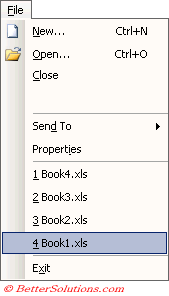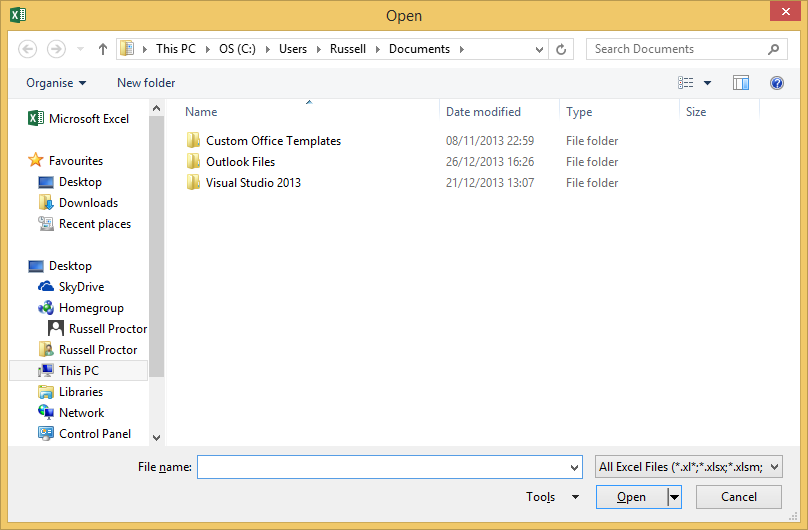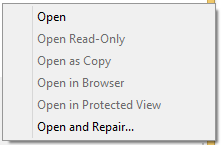Opening
You can open a workbook by selecting (File > Open) or by using the shortcut key (Ctrl + O).
Alternatively you can use the button on the Standard toolbar.
 | Open - Displays the (File > Open) dialog box. |
When you display the (File > Open) dialog box, a default folder location is used. This can be changed from (Tools > Options)(General tab, Default File Location).
If you save all your workbooks in the same folder it is definitely worth changing your default folder.
You can also double click an Excel file from within Windows Explorer. Excel files have the file extension (".xls"). If Excel is not currently open then it will open automatically.
You can also open a file using the Recently Used Menu. This is located at the bottom of your File menu (see below).
 |
By default your last 4 Excel workbooks that have been opened using the (File > Open) dialog box will be listed here. You can select one of these to quickly re-open the workbook.
You can change the number of files listed here by selecting (Tools > Options)(General tab, Recently used file list). This can be a number between 1 and 9.
If you attempt to open an Excel workbook that is already open you will be asked if you want to open a read-only copy.
Dialog Box
 |
It is possible to open more than one file by holding down the Ctrl key and selecting the files with your mouse.
Look in - Displays the folder where the workbook will be saved. To change to a different disk drive or folder, open the Look in drop-down list and click the letter of the disk drive or name of the folder. F4 or (Alt + I). Pressing F5 will refresh the list of files.
File name - The name of the file you want to open.
Files of type - Provides a list of all the different formats you can open using Excel. The default is "All Microsoft Excel files". You can find a list of all the File Extensions page.
Open - Opens the workbook that is currently selected.
Cancel - Closes the dialog box.
Back - Displays the contents of the previous file/folder list. (Alt + 1).
Up One Level - Displays the contents of the folder or drive that holds the currently displayed folder. For example, if you open the My Documents folder on drive C and then click the Up One Level button, you open your username folder (where username is the name you enter to log in to Windows). (Alt + 2).
Delete - Removes the currently selected file or folder and places it in the Windows Recycle Bin. (Alt + 4).
Create New Folder - Creates a new, empty folder on the currently selected drive or in the currently opened folder. For example, if My Documents is selected, click Create New Folder to make a folder inside the My Documents folder. When you click Create New Folder, the Create New Folder dialog box appears, asking you to type a name for the folder. Type a name that's unique and descriptive but brief and click OK. (Alt + 5).
Views - Displays a list of available ways the Save As dialog box can display the contents of the currently selected disk drive or folder:
Thumbnails (small pictures of the first page of each file), Tiles (large icons that represent folders and file types), Icons (small icons that represent folders and file types), List (filenames), Details (filenames, sizes, and dates), Properties (filenames and information), Preview (filenames with a preview of the currently selected file), or Arrange Icons (by name, file type, or date). (Alt + 6).
SS
Navigation Bar
This is displayed on the left and displays commonly accessed locations:
My Recent Documents - Displays a list of files that you have opened and folders that you have browsed to in chronological order. What are actually displayed here are shortcuts because there items have been taken from the following folder: "username"\Application Data\Recent\
Desktop - Gives you quick access to the files currently saved on the desktop.
My Documents - Displays the contents of the My Documents folder. This is normally selected by default when you first open the dialog box. This may be a different location if you have changed your Default File Location on the Options tab.
My Computer - Displays all the storage locations available on your computer including hard drives, shared folders etc.
Open drop-down menu
 |
Open - Opens the workbook allowing you to read, change and save the original file.
Open Read Only - Opens the workbook in read-only format.
Open as Copy - Opens a new copy of the original workbook. This copy is saved in the same folder as the original.
Open in Browser -
Open and Repair - This is exactly the same as selecting (Help > Detect and Repair) once the workbook is open.
Which ever status you select is displayed in the Title Bar.
Organise drop-down menu
This drop-down menu can also be activated by pressing (Alt + 7) or (Alt + L).
 |
Delete - Deletes the currently selected file (or files). This method is normally a lot slower than using Windows Explorer.
Rename -
Print -
Properties -
Important
To enable the Save As or Open dialog box to display a one-page preview of a workbook, you must turn on the Preview option for the workbook. With the workbook open in Excel, open the File menu and click Properties. Click the Summary tab and click the Save Preview Picture check box. Click OK.
This dialog box can alternatively be displayed by using the shortcut key (Ctrl + O).
You can copy, rename and delete files from within the (File > Open) dialog box.
It is possible to open multiple workbooks at the same time as long as they are in the same folder.
Hold down the Shift and Ctrl keys to allow you to select multiple files in the (File > Open) dialog box.
You can also use the right mouse button to select any file and display a shortcut menu. Just click the desired option.
This dialog box can be resized.
© 2025 Better Solutions Limited. All Rights Reserved. © 2025 Better Solutions Limited TopPrevNext